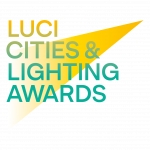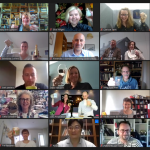Sparking the Future of Urban Lighting Highlights
Starting on 16th of May 2022, the International Day of Light, 190 participants from 38 different countries including 41 cities officially represented, gathered to celebrate the LUCI 20th anniversary. Elected officials, urbanists, lighting designers, city planners and engineers, representatives of the lighting industry, were in a brilliant mood to “spark the future of urban lighting”.
Meri Lumela, Deputy Chair of the City Board of Jyväskylä and President of LUCI, started the event by acknowledging 20 years of LUCI and warning that looking towards the future is quite challenging. “Today more than ever, we need each other, to interpret the transformation of our world”, she said, further adding that solutions are possible “if we work together and share our best recipes, the tips and tricks that we all know and need, the best practices, the sound policy and good management tools, the innovations”. She added, challenging participants to contribute to the upcoming LUCI declaration:
“The future is not only what will happen, but what we will do.”
Visions for the Future of Urban Lighting from 4 distinguished keynotes
The two first keynotes, Florence Lam, Fellow and Global Lighting Design Director of ARUP, and Mark Major, Senior Partner of Speirs Major, shared visions of people-focused cities and emphasized the importance of balance between light and darkness to conserve the qualities of the night.
Florence Lam – Shaping a sense of place for a regenerative future
As cities grow and are regenerated, a systemic approach is needed to deliver the long‐term health and wellbeing of people, place, and planet, harmonizing the symbiotic relationship between humans and biodiversity. Florence’s keynote offered a pathway on how evidence-based holistic and innovative design approach may contribute to achieving sustainable and regenerative future cities.
Mark Major – Return to the Dark City
Mark advocates that the 20th century notion of using light to extend the day should be replaced by the idea of celebrating the qualities of the night. This is not only in response to environmental concerns such as the need to save energy, reduce light pollution and waste and to protect biodiversity, but also to help improve the well-being of citizens. But lighting is an important social, economic, and place-making tool. Its presence helps keep us safe and secure while also creates identity, character, and ambience. Mark gave insights about how cities might achieve the right balance between light and darkness in the future.
On the next day, Amy Lamé, London’s Night Czar and Leni Schwendinger, Creative Director, International Nighttime Design Initiative shared their concerns about how to enhance life at night, with public lighting and how to reimagine more welcoming night environments.
Amy Lamé –Lighting for Public Life at Night
In London, holistic nighttime strategies are being created that encompass everything that happens between 6 pm and 6 am. This includes public lighting that has to be designed so that people feel welcome and safe in the city. Amy presented a set of very comprehensive research and reports, that not only help to show the inequalities and change the perception of night, but also contribute to making informed decision on nighttime planning. She also led us to discover the partnership approach and collective actions that have been put in motion since 2016 and more about London’s life at night, taking the audience on a journey through London to meet with nighttime Londoners.
Leni Schwendinger – Power to the imagination
Making references to her over 20 years of research and experience, Leni encouraged attendees to think about future effects of the warming climate, which will engender radical change, and especially more public life lived during the cool, darkened hours. She explained how more imagination is needed to have a real human approach to the night, e.g., focusing on key nightshift workers that must be regarded as space users.
She shared how urban lighting should involve more closely-knit collaborations between designers and citizens. Leni urged the audience to join the movement to transform after-dark experience into joyful, poetic, progressive scenarios, and envision welcoming night environments as dynamic, colorful, pathfinding, and satisfying spaces – in all the right places.
Sustainable Cities, Cities at night and Governance of the city roundtable discussions
The audience has been inspired by a roundtable discussion on Sustainable Cities with lighting professionals including technicians, city lighting designers, operation managers, and advisors from Budapest (HU), Ghent (BE), Gothenburg (SE), Helsinki (FI), Medellín (CO) and Tallinn (EE). In this session, roundtable participants discussed what lighting technology looks like for the future and how this can help us go a step further in developing a sustainable city.
Many interesting questions and challenges were raised for the immediate 3 to 5 coming years, including: how to scale-up ledification (in the context of higher energy prices), how far can we dim (most acknowledged that dimming 50% is not perceived by citizens), the contribution of lighting on carbon neutrality – all the while keeping a balance with safety and security, how to tackle light pollution (with major studies going on in a few cities), how to adapt lighting to less cars on the streets (guidelines and standards are missing). Some “nightmares” were also mentioned, such as cybersecurity hacks or lighting levels changing all the time.
The 2nd roundtable discussion on the future of urban lighting for the City at Night built on previous contributions, adding to a running list of important keywords to consider in shaping future cities: harmony, emotions, cooperation, communication, flexibility, accessibility, participation, education and raising awareness. This session featured the cities of Eindhoven (NL), Jyväskylä (FI), London Corporation (UK) and Oulu (FI).
The 4 speakers reflected on how cities orchestrate public lighting, coordinate, and control the lighting and the process. Time and rhythm were discussed: on investments, on pilots, on how to compose and paint lighting for the city.
Quite a few additional questions were raised here with more a “midterm” approach to the future of urban lighting: “scenario lighting” or customized lighting technologies according to seasons and users, how internal communication and cooperation inside the city can bring added value for lighting policies, how safety and security is again on top of the discussions and the challenges linked to urban lighting, the importance of directly involving citizens, but also lighting design professionals and universities.
The 3rd roundtable, entitled “the future of urban lighting for the governance of the city” included elected officials from the Lyon (FR), Jyväskylä (FI) and Tartu (EE). When asked to describe their cities’ biggest challenges, Meri Lumela (Jyväskylä) mentioned climate change that threatens the goal of carbon neutrality due to more public lighting necessary to fight longer seasonal darkness periods, Sylvain Godinot (Lyon) stated light sobriety and also the need to start a dialogue including the private sector and Raimond Tamm (Tartu) mentioned the effects of the current energy crisis that can be addressed by replacing older light sources to LED.
The cities shared the need for revised or new lighting masterplans, with balanced approaches to light and darkness, that can help find solutions to environmental challenges. They agreed that cities need to offer a vision, coordinate various actors, engage in educational and bottom up approaches to ensure the light strategies are shared by everyone.
Announcements
Two major announcements have been made during this event.

The first is the next LUCI Annual General Meeting, which will take place in Busan, South Korea on 19-22 October 2022.

The second was the launch of the first edition of the LUCI Cities & Lighting Awards. Cities can send their applications for the LUCI Cities & Lighting Awards until July 31st, 2022 – download your Application Packet 2022 to find out more!
Celebrating 20 Years with the LUCI network

During the closing celebratory moment on the first day of Sparking, we heard no less than 15 celebratory testimonials from:
Jean-Michel Daclin, Honorary LUCI President; Cathy Johnston, LUCI Honorary Member; Zoltan Pap, BDK, City of Budapest; Mikko Salmi, City of Oulu; Phil-han Kim, City of Busan; Sami Ewaida, City of Ramallah; Heather Claridge, City of Glasgow; Jeronimo Rios Sanchez, EPM Group, City of Medellín; Dae-Kwun Kim, Seoul Metropolitan Government; Daisy van Eijck-Nilwik and Willem Reedijk, City of Rotterdam; Helene Qvist, City of Albertslund; Hans Akkerman, City of Amsterdam; Clarisse Tavin, City of London Corporation; Alexandre Colombani, Former LUCI General Director and Mary-Ann Schreurs, Honorary Member.
And finally, the network raised glasses and mugs to celebrate #LUCI20years of connecting cities with light!
Images ©visitbusan.net


